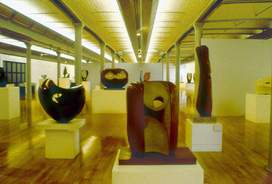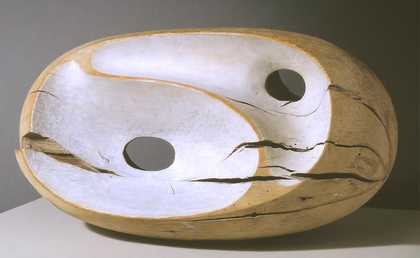Our constant aim is to elucidate the primary function whereby we bring into existence, for ourselves, or take a hold upon, space,& the object or the instrument, and to describe the body as the place where this appropriation occurs.
Maurice Merleau-Ponty 19451I rarely draw what I see – I draw what I feel in my body.
Barbara Hepworth 19662
In an interview for Studio magazine in 1946 Barbara Hepworth was asked to describe her main sources of inspiration. Anticipating her response, the interviewer volunteered that these included ‘negro sculpture, the human figure, aerodynamics, or dreams’.3 She replied simply: ‘The main sources of my inspiration are the human figure and landscape; also the one in relation to the other.’4 The relationship between the figure and landscape interested Hepworth throughout her career, but especially after moving to St Ives in 1939, and remained at the core of her work for the rest of her life. In 1966, for example, she stressed that ‘Every work in sculpture is … either a figure I see, or a sensation I have, whether in Yorkshire, Cornwall or Greece, or the Mediterranean’.5 Just a few months later she spoke about the two as if they were inseparable: ‘I cannot write anything about landscape without writing about the human figure and human spirit inhabiting the landscape. For me, the whole art of sculpture is the fusion of these two elements.’6
Despite these assertions, however, few publications have sufficiently analysed Hepworth’s particular use and development of the figure in landscape theme. This observation was first made by the curator Penelope Curtis in her article ‘The Landscape of Barbara Hepworth’ (1998), which began, ‘Landscape tends to be an obstacle in seeing Barbara Hepworth’s sculpture … The analogy has been used so frequently, and with so little care, that it is, at best, a cliché’.7 Seeking to account for this obstacle, Curtis offered two explanations. First, she suggested that there was a belated attempt on the part of art historians ‘to position Hepworth among the British Neo-Romantics who returned to the English landscape after the war’.8 Secondly, Curtis observed that critics have been ‘at a loss to codify her post-war work’ and ‘resort[ed] to the landscape as a useful bit of shorthand’.9 While acknowledging the difficulties encountered historically by critics seeking to analyse Hepworth’s engagement with the landscape, Curtis’s own investigations point towards a consideration of the physical and active nature of Hepworth’s experience of the landscape and of the viewer’s engagement with her works. For example, in her article she discussed Hepworth’s desire to make her mark on the landscape and to show works within a natural context.10 She also highlighted a quotation in which Hepworth emphasised the role of the viewer’s physical journey towards sculpture; to her friend the critic Herbert Read Hepworth wrote: ‘Imagine the critic having to climb a hill, or walk a mile through a forest … to see a sculpture.’11 These glimpses into Hepworth’s engagement with the physical experience of landscape and sculpture suggest that the theoretical discourse of phenomenology might assist in responding to important questions. How do Hepworth’s sculptures represent the figure, the landscape, or both together? And how do Hepworth’s ideas and methods affect viewers’ experiences of her sculptures?
Phenomenology is a diverse philosophical discourse united by an interest in the structures of subjective experience and the appearance of ‘phenomena’ to consciousness. Central to a number of key texts is the belief that the body is the site of perception and provides us with our ‘primary function’ of living and feeling the world.12 As a philosophical trend it comprises the work of a number of authors with varying ideas, but this study draws predominantly from the writings of Maurice Merleau-Ponty, whose influential book, Phenomenology of Perception, was published originally in Paris in 1945 and translated into English in 1962, making his theories, and the initial reception of his work, contemporary with Hepworth’s maturing career. Given the relatively late date of its translation, it is unlikely that Hepworth read Merleau-Ponty’s text and no references to the philosopher exist among the artist’s papers. This suggests that Hepworth was not aware of Merleau-Ponty’s specific contributions to philosophy and makes it unlikely that a causal relationship existed between the two. However, given the contemporaneity of Hepworth’s and Merleau-Ponty’s respective investigations into form and the nature of perception, it is perhaps possible that their ideas are to some extent socially, culturally and historically bound.
A phenomenology of perception
Merleau-Ponty’s writing is part of a philosophical tradition stemming in part from G.W.F. Hegel’s Phenomenology of Spirit of 1807. In this text Hegel argued that philosophy could not be founded on the belief that reason existed prior to experience but must be attained by experiences in the physical world.13 In the early twentieth century the philosopher Edmund Husserl positioned this debate within studies of perception, arguing that rationality was not defined by a set of pre-ordained ideas but was a continual process developed from one’s innate ability to give meaning to disordered experience. The dualism of subjective experience and objective nature was broken down, and the primacy of lived experience upheld over the empirical sciences. Gestalt psychologists of the 1930s further contributed to this debate, developing the idea that a level of reason may be obtained from the sub-conscious perceptual differentiation between a ‘figure’ and a ‘ground’.14 In Phenomenology of Perception, Merleau-Ponty described this as ‘the simplest sense-given available to us’.15
Gestaltist philosophy defined perception as a process located within the physical world rather than on an immaterial plane outside of it. The existentialist philosophy of Martin Heidegger contributed a crucial framework for this trend in thought. Heidegger explained truth as the experience of ‘being-in-the-world’, a phrase he used to acknowledge the co-dependence of world and subject, and the physical embeddedness of consciousness. Continuing in this vein, Merleau-Ponty used the phrase ‘being-at-the-world-from-within-it’, further emphasising the inevitability of contact between the body and its surrounding world.16 For Merleau-Ponty, sensory experience occurred within the body, thus ‘pure impressions’ were inconceivable and existed only as ‘sensed (sensibles)’.17 While he accepted that there were isolated objects or physical voids in the world, for Merleau-Ponty ‘an isolated datum of perception’ was ‘inconceivable’.18
Two articles on Hepworth’s work by the art writer E.H. Ramsden provide evidence of one of many potential ways in which Merleau-Ponty’s and Hepworth’s practices can be seen to converge. Although a number of excerpts from correspondence between Hepworth and Ramsden have been cited in existing literature on the artist, Ramsden’s perspective on Hepworth’s work is expressed most profoundly through her published texts.19 Importantly, Ramsden’s articles demonstrate a strong awareness of proto-phenomenological ideas, which she applied to a reading of Hepworth’s works. Ramsden does not explicitly discuss Merleau-Ponty’s ideas, but her articles strongly evoke contemporary philosophical and scientific changes in thought which can be said to have contributed to both Hepworth’s developing sculptural imagination and Merleau-Ponty’s descriptions of perception. Ramsden’s texts can therefore be used as a starting point for ascertaining the ways in which phenomenology might be used as an analytical framework with which to examine Hepworth’s developing engagement with the figure in the landscape.
Hepworth and Ramsden were good friends during the 1940s, during which time Ramsden published two important essays on Hepworth’s work. The first, ‘Barbara Hepworth: Sculptor’ was published in Horizon in June 1943 and the second, ‘The Sculpture of Barbara Hepworth’, in Polemic: A Magazine of Philosophy, Psychology and Aesthetics in the autumn of 1946.20 Ramsden and her partner Margot Eates visited Hepworth and Ben Nicholson in Carbis Bay in 1944 and possibly on more occasions.21 Hepworth and Ramsden regularly exchanged letters in which Hepworth’s work and ideas are discussed. Over sixty-five letters from Hepworth to Ramsden exist in the Tate archive, alongside more between Ramsden and Nicholson.22 From as early as 1943 Ramsden was asked by Hepworth to propose appropriate titles for her works, a fact which suggests the profound trust between the artist and writer.23
Similar in approach, Ramsden’s two articles place Hepworth’s work within the context of contemporary developments in science and philosophy. Her Horizon article starts with a quotation from the philosopher Alfred North Whitehead: ‘Our perception of natural events and natural objects … is a perception from within nature.’24 This Ramsden explained as ‘a simple statement of fact … a truth which relates indirectly to all aspects of human genius.’25 She continued:
Nature is an inclusive term and the theoretic detachment of man is as arrogant as it is fallacious. But the recognition of man’s essential unity with the forms of the world brings another acknowledgment, no less inescapable … For if it be said that man’s perceptions of Nature are from within Nature, as they indisputably are, then it cannot be denied that his intellectual activities, whether scientific or otherwise, are equally a part of Nature and belong, no less than his instincts and his passions, to the totality we call life.
In this description Ramsden extended an idea from Whitehead’s texts of man’s ‘essential unity with the forms of the world’ to all intellectual activities. However complex or abstract they had become, theories were, she emphasised, ‘equally a part of Nature’. The ideas that Ramsden associated with Whitehead can be compared with Merleau-Ponty’s denial of the Cartesian separation of body and mind and his emphasis on the grounding of consciousness in the physical world (indeed, so similar are their two philosophies that Whitehead’s work is often said to have been an influence on the younger Merleau-Ponty).26
As early as 1943, then, Ramsden connected Hepworth’s work to proto-phenomenological ideas in which a body-mind dualism was rejected and the notion of perception ‘from within Nature’ was brought to the fore. Hepworth seems to have appreciated this viewpoint, for in the summer of 1943 she wrote to Ramsden with praise: ‘I do like the thing you’ve written for Horizon.’27 Attempting to relate this philosophy to specific examples of Hepworth’s work, Ramsden emphasised Hepworth’s dependence upon scale, her sense of the figure’s response to the landscape and the relations expressed in sculptures with multiple parts. It was not until an article three years later, however, that Ramsden clarified her sense of the ways in which Hepworth’s work reflected contemporary philosophy.
In her Polemic article Ramsden continued to place Hepworth’s works within the context of developments in contemporary thought. Ramsden explained how ‘imitative methods proper to an earlier generation’ were no longer relevant to the sculptor’s aims.28 Providing a reason for this, Ramsden wrote, ‘it is no longer in the isolated form of an existence that Nature strives for him [the sculptor] but in the sublimated form of an event’.29 Crucially for Ramsden this development was transdisciplinary. She noted a contemporary trend in science which moved away from notions of empirical classifications towards an interest in processes that transform or connect. Although she gave no specific examples, she wrote, ‘In the sciences it is the notion not of substance but of function that is operative’.30 This Ramsden paralleled with the arts, remarking that it is ‘not the circumscribed “thing” but the “imageless act” of intensified experience’ to which artists now turn.31 Ramsden stressed that interest in science and in art had turned away from isolated objects or ideas towards functions and processes which recognised that the beholder’s own thoughts and experiences occurred within the physical world. Seeking an expression to summarise these manifestations, Ramsden explained:
There is a deepening conviction … that it is the modes of interconnectedness of things rather than the things themselves, the evolving curve rather than the completed figure, the process of ‘becoming’ rather than the state of the ‘become’ that is ultimately significant. It is therefore inevitable that this consciousness of the in betweenness of things, this passionate sense that:
Between the hammers lives on
our heart, as between the teeth
the tongue …………..should find expression in plastic art under new and ever more subtle determinations of sculptural form.32
Ramsden’s description of the contemporary fascination with ‘the modes of interconnectedness of things’ is key to understanding Hepworth’s use of the figure in landscape theme, in which the boundaries between subject and object are broken down and experience is recognised as a continual, lived process. Ramsden also highlighted the centrality of processes of ‘becoming’. According to the phenomenological view, things come into being as sense impressions rather than exist as pure or pre-ordained entities.33 It is, in the words of Merleau-Ponty, ‘this pre-objective realm that we have to explore in ourselves if we wish to understand sense experience’.34
In the passage quoted above, Ramsden included lines written by the poet Rainer Maria Rilke, in whose work Ramsden and Hepworth shared a keen interest. The words chosen, taken from his Duino Elegies (1923, translated in 1931), evoke the sculptor’s physical connectedness to their material and draw out the image of a sculptor operating on their work with hammer and heart, teeth and tongue. Ramsden’s choice of quotation emphasises the sculptor’s task as particularly suited to debates surrounding the relationship between ideas, feelings and the experiential world. In fact, at the beginning of her article, Ramsden introduced the sculptor’s task in these terms:
The process of transformation … is that of which the artist, above all others, is most profoundly aware. But while to recreate the patterns of experience in terms which become progressively more evanescent is for the poet sufficiently arduous a task, for the sculptor who finds himself similarly impelled the problems involved are immeasurably more complex, more formidable and more austere, since to him belongs the necessity of giving tangible shape to ideas and intuitions which ordinarily transcend the limits of the concrete and have hitherto remained beyond the aspirations of artistic faith.35
For Ramsden, the sculptor’s creation of a three-dimensional, ‘tangible’ work was upheld as having particular significance for contemporary society. She considered Hepworth’s works to be particularly exemplary of these trends because, she described, viewers were persistently aware that her abstract forms were ‘grounded in Nature’.36 This, Ramsden explained, rested ‘in no less a degree upon the sculptor’s instinctive and unfailing regard for the inherent possibilities of his material’.37 Hepworth’s sensitive approach to the intrinsic structure of materials was considered by Ramsden to be an important way in which Hepworth’s works recreated ‘patterns of experience’ and represented the processes of transforming ideas and feelings into form.
In her letters Hepworth showed a profound interest in Ramsden’s published texts. In October 1946, upon the publication of Ramsden’s second article, she described her reaction:
I think your article is one of the nicest things you’ve ever written … So silly of me to use the word ‘nice’ for something which inspires me – I very nearly started a new carving after reading it because your thoughts put me easily & freely into that world into which I am constantly striving to maintain a foothold, the plane on which idea & action become one movement … If I have done something of what you say then I am content.38
In this statement Hepworth described how Ramsden had successfully evoked ‘the plane on which idea & action become one movement’. She elaborated, ‘I have contacted the outside world through you. To be intelligible, to touch a plane, a phase, an idea with another human being means a lot’.39 Hepworth clearly felt that Ramsden had been able to express in words ideas that echoed her own ideals, and she hinted that these words could even encourage her in her work. Years later, Hepworth reflected upon the importance of this article to her career, choosing to reproduce an image of the article in her Pictorial Autobiography of 1970.40
At the end of her article in Polemic, Ramsden suggested some specific ways in which the contemporary currents of thought took shape in Hepworth’s work. She asked:
Is it not by the interpenetrations of the material … the dissolving curves of the interior and exterior surfaces, the stringing and the inner tensions of the configured whole that a sense of the cosmic rhythm of life which transcends all forms through which it is given is evoked?41
Grouped under three categories, the means Ramsden described are useful starting points for an analysis of Hepworth’s work from a phenomenological perspective. First, by looking at Hepworth’s ‘interpenetrations of the material’ or the creation of more complex relations between form and space Hepworth’s development of the figure and landscape theme can be better understood. Secondly, Hepworth’s use of stringing can be seen as a symbol expressing the connectivity between the figure and the landscape. Finally, by considering ‘the inner tensions of the configured whole’, including ambiguities of form and variety of perspectives, Hepworth’s utilisation of the temporal nature of perception can be highlighted as a critical aspect of her work.
Interpenetrations of material
In a statement written in 1951 Hepworth described how the form of a figure standing within the landscape had always been at the heart of her work. She explained:
The forms which have had special meaning for me since childhood have been the standing form (which is the translation of my feeling towards the human being standing in landscape); the ‘two forms’ – (which is the tender relationship of one living thing beside another) & the ‘closed form’, such as oval, spherical or pierced form (sometimes incorporating colour) which translates for me the association of meaning of gesture in landscape; in the repose of say a mother & child, or the feeling of the embrace of living things, either in nature or in the human spirit.42
Within her description of three types of forms, Hepworth explicitly related both the ‘standing form’ and ‘closed form’ to the experience of the landscape. She also compared ‘closed forms’ to the ‘repose’ of a mother and child and natural forms which ‘embrace’, implying a figure which is affected by these postures, motions or frames. Hepworth continued by stressing the importance of two aspects to each of these forms that are fundamental to the phenomenological view of experience: first, Hepworth noted ‘our sense of touch is a fundamental sensibility which comes into action at birth’, and, second, she highlighted the ‘stereognostic sense’ as ‘the ability to feel weight & form & assess its significance’.43 Hepworth concluded that both of these sensations should be communicated in sculpture through its relation to the human scale. She wrote:
In all these shapes the translation of what one feels about man & nature, must be conveyed by the sculptor in terms of mass, inner tensions & rhythm, scale in relation to our human size & the quality of surface which speaks through our hands as well as eyes.44
Ramsden’s article in Polemic was preceded by five photographs of Hepworth’s most recent works: Involute 1946, Elegy 1946, Pelagos 1946, Wood Sculpture 1946 and Two Forms 1945. Hepworth’s sculptural categories are not exclusive yet each of these works relate to her description of ‘closed forms’, in which round structures embrace other forms or hold internal spaces. Settled into her new home in Carbis Bay in the mid-1940s, Hepworth was prompted to recognise the landscape’s capacity to ‘embrace’ and this had an immediate effect on her re-imagination of the relations between form and space. Hepworth described how Pelagos (fig.1) was directly influenced by a view from her new house:
I had a studio room looking straight towards the horizon of the sea and enfolded (but with always the escape for the eye straight out to the Atlantic) by the arms of the land to the left and the right of me.45
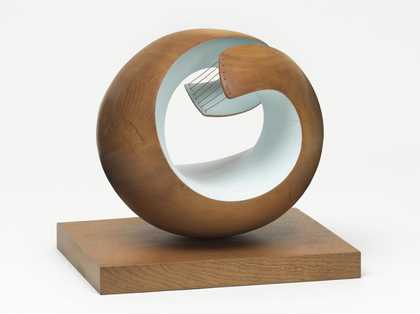
Dame Barbara Hepworth
Pelagos (1946)
Tate
As the art historian William Gibson explained in 1946, Hepworth would ‘speak not of an idea or a method … but of an emotional event, and of the fact that carvings of a certain type were done immediately afterwards’.46 Five years later Hepworth herself explained, ‘For a few years I became the object. I was the figure in the landscape and every sculpture contained to a greater or lesser degree the ever-changing forms and contours embodying my own response to a given position in that landscape’.47 Although in her language Hepworth often anthropomorphised the landscape in order to communicate the physical effect the view had on her, the form of Pelagos is not distinctly human. Like the view Hepworth described, Pelagos has ‘arms’ which enfold, but it is the relationship between these planes and the space contained inside which abstractly transcribe Hepworth’s sensation.
Although he did not directly connect Hepworth’s work to phenomenology, art historian Alex Potts described in his book The Sculptural Imagination: Figurative, Modernist, Minimalist (2000) how Hepworth’s works can draw the viewer into these spaces, becoming momentarily ‘more like architecture than sculpture’.48 Phenomenology offers a suitable discourse for discussing this effect. Merleau-Ponty explained how bodies carry ‘intentional threads’ that are connected to their surroundings, so that when seeing a landscape or a work of sculpture, it is perceived by the whole body, which feels it can enter it. ‘To look at an object … is to inhabit it’, Merleau-Ponty wrote.49 Pelagos is not entirely open to being inhabited; strings simultaneously encourage and prevent entrance in that the viewer remains aware of the sculpture as a precious and uninhabitable object.50 However, for Merleau-Ponty, physical intentionality was not dependent upon the work’s potential to be inhabited. Conversely, intentionality was for him an unavoidable and vital element of perceptual experience. An image of Pelagos was reproduced alongside Hepworth’s text ‘A Sculptor’s Landscape’, published in Drawings from a Sculptor’s Landscape in 1966. Here, Hepworth wrote, ‘The pierced hole allows bodily entry and re-entry. The spiral takes hold of one’s hand and arm’.51
Although produced for different purposes and to various specifications, the ways in which Hepworth was photographed with her sculptures indicate how she imagined the physical relationship between her works and the human figure. In most photographs where Hepworth posed with her works, she looks directly into them, makes physical contact with their inner forms or frames herself within their shapes. In a photograph with Oval Sculpture (Delos) 1955 (fig.2), which appeared in a catalogue in 1962, Hepworth rested her elbow on the sculpture’s ledge and stared up and into the work’s hollowed-out interior space, while in a photograph taken by Ida Kar in 1961, Hepworth leaned into Curved Form (Trevalgan) 1956 (fig.3), positioning her upper body within the space created by its two arms. She similarly positioned herself within the plaster of Oval Form (Trezion) 1961–3 (fig.4), stretching out her arms to interact with and inhabit its interior shapes.
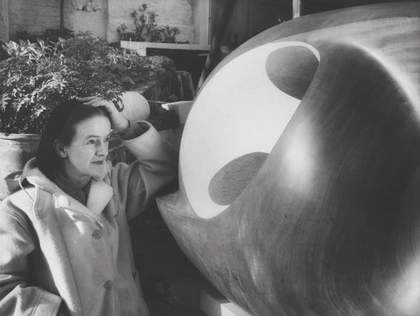
Fig.2
Barbara Hepworth with Delos 1955 in her studio at St Ives in 1955, reproduced in Barbara Hepworth: An Exhibition of Sculpture from 1952–1962, exhibition catalogue, Whitechapel Gallery, London 1962
© Bowness, Hepworth Estate: Photograph by Studio St Ives
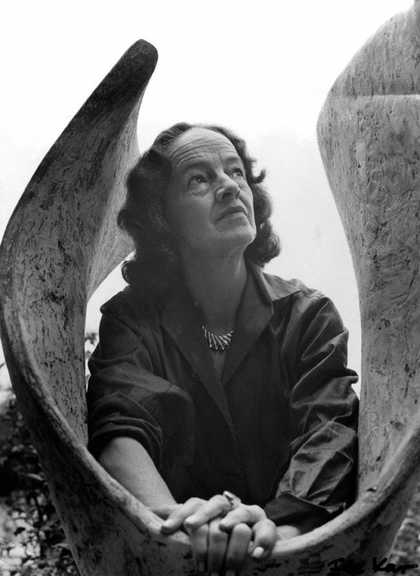
Fig.3
Ida Kar
Barbara Hepworth with Curved Form (Trevalgan) 1956 1961
National Portrait Gallery
© National Portrait Gallery, London
© Bowness, Hepworth Estate

Fig.4
Barbara Hepworth with Oval Form (Trezion) 1963 in the Palais studio 1963
© Bowness, Hepworth Estate
Photo: Val Wilmer
The progression shown in these images demonstrates the development of Hepworth’s work, which was afforded by her experimentation with bronze. From 1956 Hepworth began to devote a substantial portion of her practice to this medium, which allowed for a greater openness of form.52 From works such as Pelagos, with its inviting interior space, to Oval Form (Trezion), which Hepworth could physically reach inside, Hepworth’s work increased in size to the extent that her bronze structures became so large that viewers’ bodies could literally enter the works. For example, the viewer is invited to walk through Four-Square Walk Through 1966 (fig.5) and truly inhabit the structure, interact with its forms and other participants who enter the work.
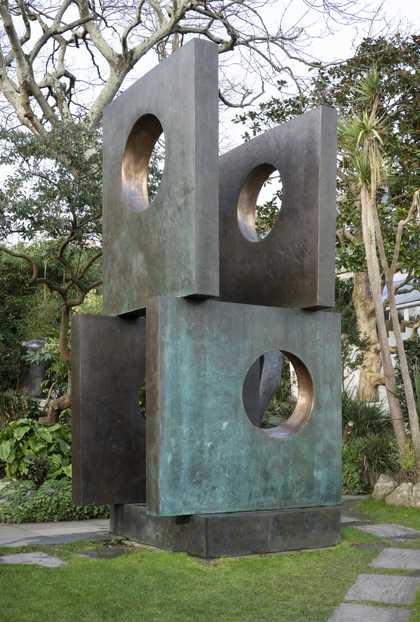
Dame Barbara Hepworth
Four-Square (Walk Through) (1966)
Lent by the Trustees of the Barbara Hepworth Estate
As early as 1937 Hepworth wrote about the importance of scale in her work. She explained, ‘Scale is not physical size … a very small thing can have good scale or a very large thing poor scale … Scale is connected with our whole life – perhaps it is even our whole intuitive capacity to feel life’.53 In 1967 she expanded that ‘This engagement helps to orientate us – give us an image of security and a sense of architecture’.54 Hepworth called her later structures, such as Four-Square (Walk Through), ‘full-scale’ works as they were planned in relation to the full dimensions of the human body. Hepworth emphasised, however, that even smaller works could have bodily scale and transcribe the sensation of being ‘held’ in the landscape. In 1966 she wrote, ‘Whenever I am embraced by land and seascape, I draw ideas for new sculpture: new forms to touch and walk round, new people to embrace, with an exactitude of form that those without sight can hold and realise’.55 In this statement Hepworth connected the tactile possibilities of sculpture to its social role – its ability to ‘embrace’ new people and be open to those even without sight. By applying her ideas about feeling embraced by the landscape Hepworth suggested that she could provide a protective, social and almost healing experience in which the body, whether physically touching the work or not, played a vital part.
The interconnectivity of string
String is a symbol of interconnectivity. It is a fibrous substance made of entwined materials and used to tie things together, weave, carry, fish with a line, or physically surround things with a net. It serves as a connective tool, linking separate things and allowing people to operate in certain ways. Yet string as a device symbolic of connectivity is not the only way in which it contributes to the meaning of Hepworth’s works.
String is a substance with particular properties which can themselves express meaning.56 Not just an abstract line, it evokes physical strength and tension. It exerts upon its viewer a sensation comparable to its own tautness, an increased sense of tension. Hepworth’s own word was that it transcribed a ‘pull’ she experienced when standing in the landscape.57 Merleau-Ponty explained how ‘the experience error’ is committed when perception is ‘made’ out of things perceived rather than things sensed.58 When dealing with sense experience, he particularly stressed that each quality of a substance has a ‘vital value’ or meaning which is grasped first by the body.59 Placed in parallel or weaved together, Hepworth’s strings often create patterns on which the eye can never rest and the movement of these sense organs has its own ‘perceptual significance’. This sense of vibrating unrest parallels the material’s own sensitivity to movement.60 It is telling that Hepworth often used string to compose the vibrating, sensitive surfaces of wings. Hepworth made Stringed Figure (Curlew) (fig.6) in 1956, one year after designing winged costumes and props for the set of Michael Tippett’s production of The Midsummer Marriage (fig.7). Composed of similarly long, thin partitions of material painted bright white, these set designs induce a similar sense of vibrating activity.
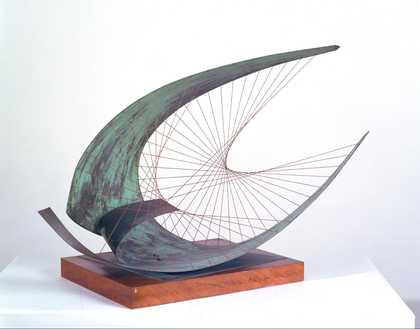
Dame Barbara Hepworth
Stringed Figure (Curlew), Version II (1956, edition 1959)
Tate
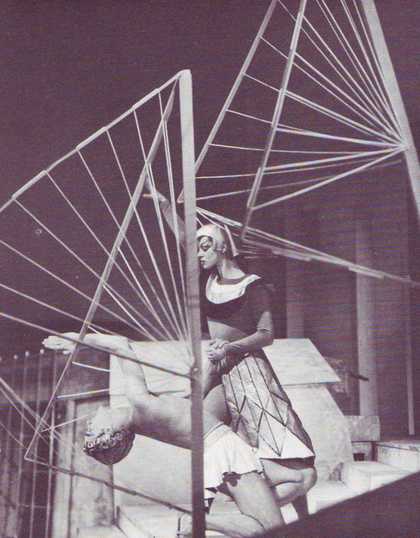
Fig.7
Barbara Hepworth, ‘Ritual Dance’ constructions for Michael Tippett’s The Midsummer Marriage, performed at the Royal Opera House, London, January 1955, reproduced in Barbara Hepworth, A Pictorial Autobiography, Bath 1970, p.68
© Bowness, Hepworth Estate
Steel rod, used by Hepworth from the beginning of the 1950s, has a similar effect to taut string. Apollo 1951 (fig.8) was created as a character for a production of Sophocles’s Electra directed by Michel St Denis in London that year. Most effectively seen in the context of the play, Apollo describes the vibrating energy of the god of light and the material’s tensile structure enabled Hepworth to produce an emphatically gestural, expressive shape suited to the work’s character role.61 Hepworth described how she was influenced by a sight of a figure within the landscape near St Ives, recalling how it became not only ‘a strong column, a thrust out of the land’ but also ‘a rising form which reaches outwards and upwards’.62 The reciprocity of perception and expression was a crucial concept to Merleau-Ponty, who said, ‘Insofar as I have hands, feet; a body, I sustain around me intentions which are not dependent on my decisions and which affect my surroundings in a way that I do not choose’.63 For him, as the body was constantly striving towards the world, seeking to know it, it continually expressed its co-existence and contributed meaning. A reciprocal relation was established with things perceived and categories of subject and object ceased to apply.

Fig.8
Barbara Hepworth, Apollo 1951, with Peggy Ashcroft as Electra in Michel St Denis’s production of Sophocles’s Electra at the Old Vic theatre, London 1951, reproduced in Barbara Hepworth, A Pictorial Autobiography, Bath 1970, p.61
© Bowness, Hepworth Estate
Hepworth was especially pleased to note how physical marks showed on her works where they had been touched and stroked. After her exhibition at the Whitechapel Gallery in 1962, she wrote:
One of the things that pleased me most after my recent show … was to observe when my work came back to St Ives, how much the pieces had been touched by visitors to the exhibition. I could tell by the marks on them just where, and how they had been touched, felt, caressed. Their hands had followed the main rhythms and movements of the forms.64
Not only did Hepworth recognise an intuitive desire to approach and touch her sculptures but she also found the ways in which they had been touched important signals of the works’ effects. In Merleau-Ponty’s view, as perception entailed a physical intentionality towards things perceived, space was a ‘theatre of action’ in which one’s phenomenal body ‘surges towards objects to be grasped’.65 Hepworth’s works from this time represent her corporal and sensual responses to landscapes and they encourage viewers to respond in comparable ways. With this in mind, it is telling that, during the 1940s, Hepworth increasingly sought to locate works outside of the gallery space, preferring instead the surroundings of gardens or public spaces, where tactile, expressive reactions to her work would be more commonplace or acceptable.
In Garden Sculpture (Model for Meridian) 1958 (fig.9) Hepworth developed her experiments with string and steel rod in a way that further broke down conventional notions of acting and receiving, perception and expression. Garden Sculpture is close in stature to Hepworth’s contemporary Torso series, but, composed of an arrangement of thin, wire-like bronze rings, this work represents more than a figure’s singular form. In the 1937 constructivist publication Circle Hepworth described the sensation of standing in the landscape in the following terms: ‘The consciousness and understanding of volume and mass, laws of gravity, contour of the earth under our feet, thrusts and stresses of internal structure, space displacement and space volume, the relation of man to a mountain … these are surely the very essence of life.’66 This is an early description of embodied perception, of the inseparability of external events from physical sensations felt within the body. While Garden Sculpture is figurative, it does not describe one figure but rather the space where interconnectivity plays its part. In 1988 the Merleau-Ponty scholar M.C. Dillon described the implications of the French philosopher’s theory of reversibility, writing:
There is no representation at the level of perception: there is only flesh in touch with itself … That is the essence of the reversibility relation; not that the tree I see sees me, but that I am visible from the standpoint of the tree as it is from mine because we are both made of the same stuff: the flesh of the world.67

Dame Barbara Hepworth
Garden Sculpture (Model for Meridian) (1958)
Tate
Inner tensions of the configured whole
It is precisely Gestalt psychology which has brought home to us the tensions which run like lines of force across
the visual field … and which breathe into it a secret and magic life by exerting here and there forces of distortion, contraction and expansion.
Maurice Merleau-Ponty 194568
Writing about Pendour 1947–8 (fig.10) Alex Potts observed that Hepworth’s works take on varying characters when they are seen from different viewpoints.69 He noted that Pendour looks solid from one side and hollow from another, depending on whether large cavities are in view. This was heightened, Potts explained, by the difference between colours painted onto the hollowed surfaces visible from either side: light blue on one and white on the other.

Fig.10
Barbara Hepworth
Pendour 1947–8
Hirshhorn Museum and Sculpture Garden, Washington D.C.
© Bowness, Hepworth Estate
© Hirshhorn Museum and Sculpture Garden
Hepworth had always played with the viewer’s moving perceptions of her work, but especially during the 1940s and 1950s, the complexity of her forms created intentionally mysterious relations between their parts. Hepworth noted how Corinthos 1954–5 could take on a variety of characters, having a heavy outer shape that, when seen from a distance, hides a surprising expanse of tunnels inside. Hepworth recognised that a photograph, which cannot trace movement, could not easily represent the work. ‘It is a very difficult one to do well’, she wrote to the Tate Gallery, ‘due to the relation of inside and outside carving, i.e. if you get all the outside, you hardly see the inside.’70
The variety of perspectives attained within experience caused Merleau-Ponty to reflect further upon the nature of perception. He asked, ‘How can any thing ever really and truly present itself to us, since its synthesis is never a completed process, and since I always expect to see it break down and fall to the status of a mere illusion?’71 Responding positively, however, he resolved, ‘Yet there is something and not nothing … the fact remains that the perceived stone is there, that I recognise it, that I have named it and that we agree on a certain number of statements about it’.72 As a result we are, he said, led to a contradiction of perspectives which always suggest something more that we cannot see. The contradiction is naturally resolved, he continued, upon the recognition that we operate in time and understand time as ‘the measure of being’.73
Time, for Merleau-Ponty, was central to the perceptual process. Located in an always changing present time, experience, he proposed, was made out of those moments immediately previous to the present as well as those in the nearing future. We do not ‘build up’ a picture of a complete object by reflecting on it after the event, he insisted, but instead a body ‘takes possession of time’ and ‘brings it into existence’, creating time, therefore, rather than submitting to it.74 When discussing the temporal aspect of perception, Merleau-Ponty was particularly high-spirited. His sentences betray a sense of joy in the ambiguity that defines experience from the most fundamental perceptions of a figure on a ground.75 ‘Temporality is not some half-hearted existence’, Merleau-Ponty wrote.76 The distortions, contradictions and expansions that do not allow us to have absolute certainty are precisely those things which he explained ‘breathe’ into us ‘a secret and magic life’.77
In 1941 Hepworth wrote to the critic Herbert Read about the importance of gestalt psychology:
I’m most particularly interested in Gestalt psychology and agree with you about its significance … Constructivism does not do away with imagery – in fact it contains the most easily understood use of images – basic forms of the rhythm of the landscape … they are organic, capable of infinite variation and are socially significant from primitive man onwards. I could write a book about the crystal and the potato.78
For Hepworth, too, a sense of pleasure surrounds her discussions on the perception of forms ‘capable of infinite variation’. Significantly, in the above statement, she connected this pleasure to constructivist investigations into form, finding such means particularly relatable to the ‘rhythm of the landscape’ around West Penwithin Cornwall. It is in works such as Pelagos, Pendour and Corinthos, for instance, that Hepworth so successfully combined a constructivist instinct for variety of form with an increasingly corporal physicality. While it is possible that this development may have occurred without Hepworth’s relocation to St Ives in 1939, the artist’s strong sense of the importance of landscape experienced during this time cannot be ignored within discussions of her work.
In 1949 Hepworth moved into Trewyn, the house, workshop and garden where she was able to create and to display works within a garden setting. Under these circumstances, Hepworth was able to strengthen the connection between her works and the experiences of perception and organic forms. Visitors were encouraged to take the trip to Trewyn to experience the works in their ‘natural’ habitat. Yet Hepworth’s particular fondness for placing works in this environment was not simply a symbolic process of returning forms to the locations from where they were conceived. Rather, Hepworth’s choices were firmly rooted in her belief in the importance of variety and movement to the perceptual experience of form.
At different points throughout her career, Hepworth had sited sculptures in outdoor locations. As curator Chris Stephens has recalled, two large works by Hepworth were placed in the Hampstead gardens (those of Hepworth and Roland Penrose) in the 1930s, and during the war Hepworth occasionally photographed her sculptures in front of the bay at St Ives.79 As Stephens noted, after the war ‘this dialogue between art work and nature came to the fore’ and Trewyn became the ‘principal location for this exchange’.80 In April 1943 Hepworth and Ramsden had a written conversation on this topic. Hepworth contested Ramsden’s dislike of a photograph of an earlier work entitled Single Form, which Hepworth had taken outside because, she wrote, ‘when I conceived Single Form it was born of this particular sort of landscape’. Her subsequent explanation suggests further motivations.
I’m sick of sculptures in galleries & photos with flat backgrounds. I don’t refute the validity of either or indeed the truth & strength of the tactile & architectural conception either – but no sculpture really lives until it goes back to the landscape, the trees, air & clouds … I can’t help it – I shan’t be truly happy until this is more fulfilled – it will be – even if it is only my own tombstone in Zennor!81
While Hepworth recognised the potential ‘strength’ of gallery rooms, she stressed the variety of changeable, moving elements which she sought in outdoor locations, including the trees, air and clouds – features which would further contribute to her works’ varied forms, appearances and effects.
In a number of later commissions, Hepworth was asked to incorporate water into her plans – opportunities which she relished. While these schemes were often impacted by other factors, including, for example, the need to integrate sculpture within an architectural setting, Hepworth seemed to enjoy these projects and her use of water continued an important development of re-exposing her works to natural, organic and changeable elements. In May 1965 Hepworth was asked by AberdeenArtGalleryand IndustrialMuseumto consider a work that could be part of a fountain installation. The gallery’s director, Charles Carter, chose Oval Form (Trezion) from a selection of images Hepworth provided. Hepworth was clearly thrilled with their choice. She wrote:
I think you would find most fascinating results as there are so many channels through the sculpture and so many arcs where you would have droplets that the whole pattern of the water should be quite fascinating to contemplate.82
Hepworth later provided the gallery with a sketched design which showed the paths of various water projections (fig.11). She also described the viewer’s possible perspectives of the work. A parapet should elevate both pool and work, so that when sitting on this base, the viewer could ‘look in and under the sculpture’, and when stood up, ‘one could look through and down into it’.83
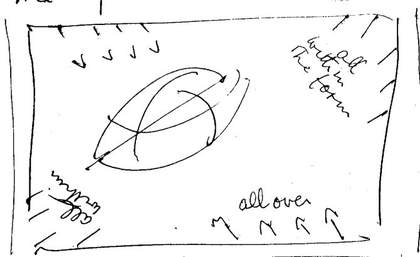
Fig.11
Barbara Hepworth
Sketch of Oval Form (Trezion) 1961–3 with proposed water projections, 1965, in photocopy of letter to Charles Carter, Director of Aberdeen Art Gallery and Industrial Museum, undated [Summer 1965], Tate Archive TGA 965
© Bowness, Hepworth Estate
Formally, the water projections Hepworth proposed were specifically related to the structure of the work. In October Hepworth wrote to Carter explaining that she would prefer ‘low arcs of water reaching it and then from the nearer side, high arcs, which would repeat in water pattern the curves of the sculpture itself’.84 Hepworth planned, therefore, to expand her form with moving water and to enliven the work with this interaction. Water could pass through the work, emphasising its accessible interior spaces, and its movement would offer continually or rhythmically changing gestalt impressions of the overall form. Varied surface patterns would develop from both the deposits of water on the work’s surfaces and gradually evolving patinas. Hepworth further suggested that the water-jet nozzles could be turned so that further variety could be obtained. She wrote:
you could also entirely change the water display when you felt so inclined; i.e. you could go so far as to put all the jets straight into the pool without going through the sculpture at all or on the left the jets can go through the sculpture and the ones of the nearer side can go over the sculpture. It would seem to me to allow of infinite variation.85
Echoing her discussion of gestalt psychology, Hepworth consistently upheld the quality of ‘infinite variation’ in these displays. While her work remained rooted to the constructivist aesthetic, which she associated with the variety of impressions offered by a work, Hepworth sought to enhance a sense of her sculptures’ aliveness by displaying them in outdoor locations and integrating their structures with the fluid, changing substance of water. The central impulse of her works, therefore, remained the same. Sculpture was, for Hepworth, foremost a rhythmic, living force, embedded within the organic world and immovable from the tensions and processes of transformation implicit in nature and human experience.
Ramsden’s published writings on Hepworth’s works placed them in a discourse that was to some extent influenced by phenomenological terms and ideas. These recognised an increasing dissatisfaction with empirical notions of the object and upheld in their place the role of connectivity and the physically-grounded nature of perception. However, it must be acknowledged that Ramsden did not explicitly highlight the body as the site where interconnections and perceptual processes occur. And in Hepworth’s early statements it is rare for the artist to describe her experiences as corporal incidents. For example, in 1937 she defended her work from physical interpretation, writing, ‘The idea – the imaginative concept – actually is the giving of life and vitality to material; but when we come to define these qualities we find that they have very little to do with the physical aspect of the sculpture’.86 Yet Hepworth did eventually come to recognise the body’s role in perceptual experience, writing in 1966 of her drawings, ‘I rarely draw what I see, I draw what I feel in my body’.87
It is possible that it was Hepworth’s prolonged engagement with the figure in landscape theme that encouraged her own gradual acceptance of the role of the body – both her own and those of viewers – as the site of experience, and that the works she made after the Second World War reflect contemporary phenomenological concerns with the temporal aspects of perception and the bodily experience of meaning. Even if Hepworth never read the writings of Merleau-Ponty, phenomenology can offer a valuable critical perspective from which to discuss otherwise mute or aloof notions of interconnectivity and ‘in betweenness’, helping to express a coalescence of subject and object, body and environment, figure and landscape.

